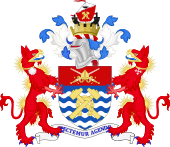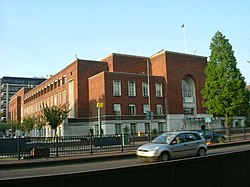| Hammersmith and Fulham London Borough Council | |
|---|---|
 Coat of arms Coat of arms | |
 Logo Logo | |
| Type | |
| Type | London borough |
| Leadership | |
| Mayor | Patricia Quigley, Labour since 24 May 2023 |
| Leader | Stephen Cowan, Labour since 22 May 2014 |
| Chief Executive | Sharon Lea since 24 February 2022 |
| Structure | |
| Seats | 50 councillors |
 | |
| Political groups |
|
| Elections | |
| Voting system | First past the post |
| Last election | 5 May 2022 |
| Next election | 7 May 2026 |
| Meeting place | |
 | |
| Town Hall, King Street, Hammersmith, London, W6 9JU | |
| Website | |
| www | |
Hammersmith and Fulham London Borough Council, which styles itself Hammersmith and Fulham Council, is the local authority for the London Borough of Hammersmith and Fulham in Greater London, England. It is a London borough council, one of 32 in London. The council has been under Labour majority control since 2014. The council's usual meeting place is at Hammersmith Town Hall.
History
The London Borough of Hammersmith (as it was originally named) and its council were created under the London Government Act 1963, with the first election held in 1964. For its first year the council acted as a shadow authority alongside the area's two outgoing authorities, being the metropolitan borough councils of Fulham and Hammersmith. The new council formally came into its powers on 1 April 1965, at which point the old districts and their councils were abolished.
The council changed the borough's from 'Hammersmith' to 'Hammersmith and Fulham' with effect from 1 April 1979. Since then, the council's full legal name has been "The Mayor and Burgesses of the London Borough of Hammersmith and Fulham", but it styles itself Hammersmith and Fulham Council.
From 1965 until 1986 the council was a lower-tier authority, with upper-tier functions provided by the Greater London Council. The split of powers and functions meant that the Greater London Council was responsible for "wide area" services such as fire, ambulance, flood prevention, and refuse disposal; with the boroughs (including Hammersmith and Fulham) responsible for "personal" services such as social care, libraries, cemeteries and refuse collection. The Greater London Council was abolished in 1986 and its functions passed to the London Boroughs, with some services provided through joint committees. Hammersmith and Fulham became a local education authority in 1990 when the Inner London Education Authority was dissolved.
Since 2000 the Greater London Authority has taken some responsibility for highways and planning control from the council, but within the English local government system the council remains a "most purpose" authority in terms of the available range of powers and functions.
The council was involved in a landmark English administrative law case in 1991, Hazell v Hammersmith and Fulham LBC, which ruled that local authorities had no power to engage in interest rate swap agreements because they were beyond the council's borrowing powers.
In 2021 the council was said by the Housing Ombudsman to be the worst performing landlord in the country with regard to damp and mould in its properties.
Powers and functions
The local authority derives its powers and functions from the London Government Act 1963 and subsequent legislation, and has the powers and functions of a London borough council. It sets council tax and as a billing authority also collects precepts for Greater London Authority functions and business rates. It sets planning policies which complement Greater London Authority and national policies, and decides on almost all planning applications accordingly. It is a local education authority and is also responsible for council housing, social services, libraries, waste collection and disposal, traffic, and most roads and environmental health.
Political control
The council has been under Labour majority control since 2014.
The first election was held in 1964, initially operating as a shadow authority alongside the outgoing authorities until it came into its powers on 1 April 1965. Political control of the council since 1965 has been as follows:
| Party in control | Years | |
|---|---|---|
| Labour | 1965–1968 | |
| Conservative | 1968–1971 | |
| Labour | 1971–1978 | |
| No overall control | 1978–1986 | |
| Labour | 1986–2006 | |
| Conservative | 2006–2014 | |
| Labour | 2014–present | |
Leadership
The role of Mayor of Hammersmith and Fulham is largely ceremonial. Political leadership is instead provided by the leader of the council. The leaders since 1965 have been:
| Councillor | Party | From | To | |
|---|---|---|---|---|
| John Heaks | Labour | 1965 | 1966 | |
| Anthony Chapman | Labour | 1966 | 1968 | |
| William Smith | Conservative | 1968 | 1971 | |
| Alfred Little | Labour | 1971 | 1973 | |
| Barry Stead | Labour | 1973 | 1978 | |
| Stuart Leishman | Conservative | 1978 | 1979 | |
| Kim Howe | Conservative | 1979 | 1985 | |
| John Putnam | Conservative | 1985 | 1986 | |
| Gordon Prentice | Labour | 1986 | 1988 | |
| Mike Goodman | Labour | 1988 | 1991 | |
| Iain Coleman | Labour | 1991 | 1996 | |
| Andy Slaughter | Labour | 1996 | 25 May 2005 | |
| Stephen Burke | Labour | 25 May 2005 | 7 May 2006 | |
| Stephen Greenhalgh | Conservative | 24 May 2006 | 30 May 2012 | |
| Nick Botterill | Conservative | 30 May 2012 | 22 May 2014 | |
| Stephen Cowan | Labour | 22 May 2014 | ||
Premises
The council's usual meeting place is at Hammersmith Town Hall on King Street, which was completed in 1939 for the old Hammersmith Borough Council. The building has been closed since 2019 whilst being refurbished as part of the development of a new 'Civic Campus' around it, which has included the demolition of the council's former main offices which had been built in front of the Town Hall in 1974/5. The Town Hall is due to reopen in 2024.
Elections
See also: Hammersmith and Fulham London Borough Council electionsSince the last boundary changes in 2022 the council has comprised 50 councillors representing 21 wards, with each ward electing two or three councillors. Elections are held every four years.
See also
References
- "Council minutes, 24 May 2023". Hammersmith and Fulham Council. 24 May 2023. Retrieved 7 April 2024.
- "Council report, 24 May 2023" (PDF). Hammersmith and Fulham Council. Retrieved 7 April 2024.
- "London Government Act 1963", legislation.gov.uk, The National Archives, 1978 c. 33, retrieved 16 May 2024
- "Historical information from 1973 onwards". Boundary-Line support. Ordnance Survey. Retrieved 17 February 2023.
- "Cabinet agenda, 6 November 2023" (PDF). Hammersmith and Fulham Council. p. 121. Retrieved 9 April 2024.
- "Local Government Act 1985", legislation.gov.uk, The National Archives, 1985 c. 51, retrieved 5 April 2024
- Education Reform Act 1988 (c. 40)
- Leach, Steve (1998). Local Government Reorganisation: The Review and its Aftermath. Routledge. p. 107. ISBN 978-0714648590.
- "Hazell -v- Hammersmith and Fulham London Borough Council; HL 1991". swarb.co.uk. 9 July 2015. Retrieved 11 July 2015.
- "Council launches damp and mould strategy after topping ombudsman's worst performers list". Inside Housing. 10 February 2022. Retrieved 10 February 2022.
- "Council Tax and Business Rates Billing Authorities". Council Tax Rates. Retrieved 8 April 2020.
- "Local Plan Responses – within and outside London". Mayor of London. 12 November 2015. Retrieved 9 April 2020.
- "Compositions calculator". The Elections Centre. 4 March 2016. Retrieved 3 March 2023.
- "Council minutes". Hammersmith and Fulham Council. Retrieved 1 July 2022.
- "London Boroughs Political Almanac". London Councils. Retrieved 1 July 2022.
- Historic England. "Hammersmith Town Hall (Grade II) (1079785)". National Heritage List for England. Retrieved 7 April 2024.
- "Civic Campus". Hammersmith and Fulham Council. Retrieved 7 April 2024.
- "H&F Council's new King Street Service Centre is now open". Hammersmith Today. 13 September 2019. Retrieved 7 April 2024.
- "The London Borough of Hammersmith and Fulham (Electoral Changes) Order 2020", legislation.gov.uk, The National Archives, SI 2020/1229, retrieved 7 April 2024
External links
| Awards and achievements | ||
|---|---|---|
| Preceded byLeicestershire | LGC Council of the Year 2010 |
Succeeded byBlackburn with Darwen |

